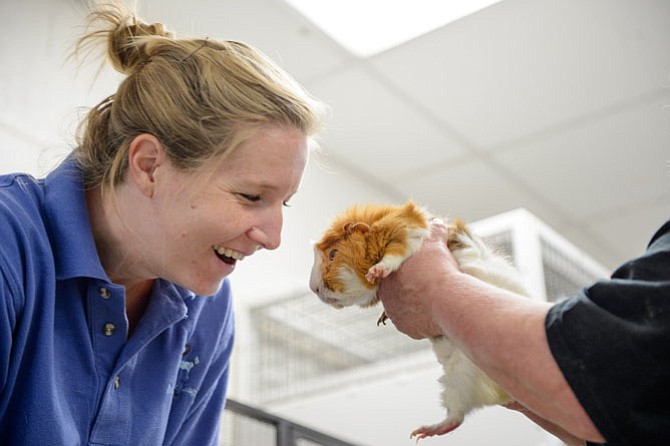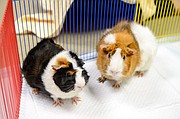Animal Care Technician Miriam Diemer meets a visiting guinea pig called Copper. Photo by Shelley Castle Photography
Life at Alexandria’s Vola Lawson Animal Shelter is about more than cuddly cats and adorable dogs. A variety of “small animals” — rabbits, ferrets, turtles, snakes, even the occasional chicken — make up the shelter’s diverse community. And then there are the guinea pigs, each with its own personality.
“Some of the guinea pigs will start making a whistling sound, especially when one particular volunteer arrives — they really bond with her,” says Joanna Fortin, the shelter’s Community Outreach and Adoptions manager. They get excited when she stuffs an empty toilet paper roll with hay and fruit — fruit is a favorite guinea pig treat —and hangs it from the ceiling of the cage. “They grab it over and over with their mouth, and it swings like a piñata until it cracks open and the food comes out,” Fortin said.
About 80 guinea pigs arrive at the shelter every year, she said, often resulting from “accidental litters” born to pets in Alexandrians’ homes. After a medical checkup, those “pigs” deemed ready for adoption are sustained with daily supplies of hay, pellets and a variety of vegetables grown in the shelter’s garden or provided by green-thumbed volunteers.
But guinea pig psychology can be complex, especially when trying to pair two of the animals in the same cage. So the shelter, which is operated by the Animal Welfare League of Alexandria, recently invited Metropolitan Guinea Pig Rescue (MGPR) to demonstrate best guinea pig practices for staff and volunteers. A copper-colored neutered male guinea pig called Copper and a tri-color female named Camellia came along to help out.
Guinea pigs come in dozens of breeds, each with its own distinct personality, MGPR Director Becky Wilson and her colleague Deb Jackson told the group. American Shorthair guinea pigs tend to be playful and inquisitive. Abyssinians — known for the rosettes of fur all over their coats — are on the pushy side, wanting everything on their own terms. And the long-haired breeds tend to be sweet and submissive and just want to be cuddled. All guinea pigs need abundant, fresh hay every day; gnawing on it helps keep their constantly growing teeth in check. High-quality pellets and a rich variety of vegetables should round out their diet.
Determining the gender of a guinea pig is difficult, Wilson said, as she showed the group how best to do that. And spaying and neutering guinea pigs can be challenging for veterinarians, so it’s important to find a vet who has extensive experience in the procedures.
Guinea pigs hate to live alone, Wilson said. “Imagine sitting in a cage day after day, waiting for someone to come and provide some diversion,” she said. But MGPR doesn’t advise putting two males in the same cage — they often will fight, sometimes viciously. And pairing two females requires a special protocol to ensure healthy bonding: The family female pet should be temporarily removed from the cage, and the cage thoroughly scrubbed to banish her scent. New food and water bowls should be provided. Then, the new female “pig” should be introduced to the cage, followed about 20 minutes later by the original pet. Bonding should follow, and one of the two animals generally will emerge as dominant.
Wilson and Jackson provided some guidelines for those about to enter the world of the guinea pig:
- Guinea pigs are not the best starter pets for young children. For one, they are generally too large for a young child to handle. And, parents should realize that the average well-cared-for guinea pig lives five to eight years, well beyond the attention span of many young children.
- Guinea pigs need extensive space to move around in, so cages should be larger than most people believe — at least 4 square feet. Small cages always tend to be dirty and stinky, Wilson says, which is unpleasant for both the animal and the owner.
- Guinea pigs want more out of life than sitting in a cage — they want people. They need to be taken out of the cage for at least 20 minutes a day to play and even brought outdoors if possible. When given the chance, some of the younger guinea pigs will charge around the house like a racehorse. Others like quiet time. “Many guinea pigs will sit in your lap to watch TV or read with you, and they will purr when you scratch their head, just like a cat,” Wilson said.
Operated by the Animal Welfare League of Alexandria, the Vola Lawson Animal Shelter is at 4101 Eisenhower Ave., Alexandria. Visit www.alexandriaanimals.org or call 703-746-4774.

